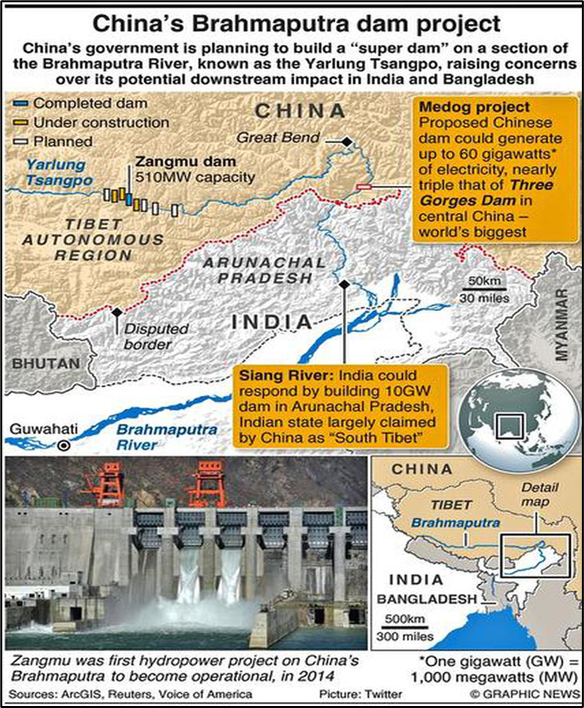Why in News?
- Fearing a Chinese threat of “water wars”, India has initiated its biggest hydroelectric project of 11,000 megawatt (MW) in upper Subansiri in Arunachal Pradesh.
What’s in today’s article:
- Background (China’s Hydroelectric Project, Why China is Building the Dam, etc.)
- Impact on India (Impact on Agriculture, Water Resources, Seismological, Environmental, etc.)
- India’s Response (11GW Project, Other Stalled Projects activated, etc.)
Background:

- China is building a 60,000 MW dam on the Yarlung Tsangpo River. The project was announced in 2021.
- The Yarlung Tsangpo is the upper stream of the Brahmaputra River located in the Tibet Autonomous Region, China.
- It is the longest river of Tibet.
- Once completed, it will be the world’s largest hydroelectric dam.
- The under-construction dam is in Medog country, Tibet which is in close proximity to Arunachal Pradesh.
- India is concerned about the construction of this dam in China.
Why is China building the Dam?
- According to the Chinese officials, the hydroelectric project is part of the country’s renewable energy generation initiatives.
- It will produce three times more hydroelectric power than China’s current largest dam, the Three Gorges Dam.
- It will help China achieve carbon neutrality by 2060 and also pave way for development in the Tibet Autonomous Region.
- In 2010, China had begun construction of small dams along the mainstream of the Yarlung Tsangpo, two of them have already been completed and at least three are under construction.
What will be the Impact on India?

- Agriculture –
- Such a huge dam could hold back massive amount of silt carried by the river.
- Silty soil is more fertile than other types of soil and it is good for growing crops.
- This could affect farming in the areas downstream.
- Water Resources –
- The construction of dams upstream will have a significant effect on areas downstream.
- China has claimed that it is building a run-of-the river hydropower project, which do not involve storage or diversion of the waters of the Brahmaputra.
- Run-of-the-river hydroelectric systems harvest the energy from flowing water to generate electricity.
- However, experts say it could still reduce water flow downstream, especially during the dry season.
- India is also worried about the release of water during the monsoons, when north-eastern states such as Assam experience floods.
- If China released water from the dam, it could be disastrous for an already inundated Assam.
- Seismological Impact –
- The Himalayan region is vulnerable to earthquakes and other seismic activities.
- The sheer size of the infrastructure projects undertaken there poses a significant threat to the populations living downstream.
- Ecological Impact –
- Several species of flora and fauna are endemic to this part of the world and some of them are critically endangered.
- The ecosystem in the Himalayan region is already on the decline. The glaciers have been retreating due to climate change.
- Deforestation, soil erosion and landslides are some of the other issues here.
- The combined dam plans of China and India could have disastrous consequences in this ecologically sensitive zone.
Water as a Weapon?
- Being an upstream area, China has a clear advantage in building dams and other infrastructure to store or divert the flow of the river system.
- There is the potential to significantly change the flow rate during times of standoff between the countries.
- India has agreements with China that require the latter to share hydrological data of the river during monsoon season between May and October.
- The data is mainly of the water level of the river to alert downstream areas in the event of floods.
- However, during the Doklam border standoff (2017) between India and China, China stopped communication of water flow levels from its dams.
- Though data sharing resumed in 2018, India has reasons to believe that China may withhold data.
India’s Response:

- For India, the Brahmaputra accounts for nearly 30% of freshwater resources and 40% of total hydropower potential of the country.
- In order to protect her interests, India has initiated its biggest hydroelectric project of 11,000 MW in upper Subansiri in Arunachal Pradesh.
- This project is also seen as significant for the people of Arunachal Pradesh in terms of livelihood and employment opportunities.
- After this project, the risk of floods will also reduce considerably.
- India is also expediting three stalled projects for possible allocation to National Hydro Electric Power Corporation (NHPC).
- India’s 2,000 MW project on Subansiri could be completed by the middle of 2023.
- These multiple hydroelectric projects, apart from generating electricity, are expected to help mitigate water scarcity for up to a year in case of a Chinese diversion.
- These projects will also help in controlling flooding in case China releases unusually high volumes of water.









